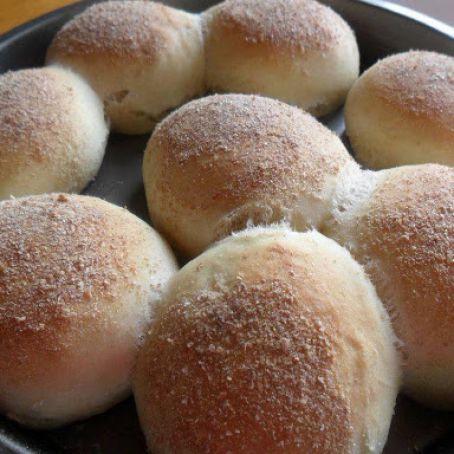Pandesal
By vlacer
 1 Picture
1 Picture
Ingredients
- 2 cups warm water or 475 ml warm water (110 degrees F/45 degrees C)
- 2 teaspoons active dry yeast
- 1/3 cup white sugar
- 1/4 cup vegetable oil
- 1 1/2 teaspoons salt
- 6 cups all-purpose flour
Details
Preparation
Step 1
Put the warm water in a small mixing bowl and add the yeast and 1 teaspoon of the sugar; stir to dissolve. Let stand until creamy, about 10 minutes.
In a large mixing bowl, combine the remaining 15 teaspoons of sugar and the oil and mix until smooth. Add the salt, 1 cup of flour and the yeast mixture; stir well. Add the remaining 5 cups flour, 1/2 cup at a time, until the dough pulls away from the sides of the bowl.
Turn the dough onto a lightly floured surface and knead until smooth, supple and elastic; about 10 minutes. Lightly oil a large mixing bowl, place the dough in it and turn to coat the dough with oil. Cover with a damp towel or plastic wrap and let sit in a warm place until the dough has doubled in volume; about 1 hour.
Turn the dough onto a lightly floured surface (Stretch the though a bit so it forms a rectangular shape) and divide into 4 equal pieces. Form each piece into a cylinder and roll out until the ‘log’ is 1/2 inch in diameter. Using a sharp knife or a dough cutter, cut each ‘log’ into 1/2 inch pieces.
Roll each piece in breadcrumbs making sure the the whole roll is covered.
Place the pieces, flat side down, onto two lightly greased baking sheets. Gently press each roll down to flatten.
Preheat oven to 375 degrees F (190 degrees C).
Cover the rolls with a damp cloth and let rise until doubled in volume, about 30 minutes.
Bake at 375 degrees F (190 degrees C) until golden brown, about 20 minutes.
If you have a BREADMAKER, here are the directions to make pandesal:
Put the warm water in a small mixing bowl and add the yeast and 1 teaspoon of the sugar; stir to dissolve. Let stand until creamy, about 10 minutes.
In the breadmaker’s pan, pour 60 mls of vegetable oil
Pour in the remaining 15 teaspoons of sugar and then the 1 and 1/2 teaspoons salt
Add the 6 cups of all-purpose flour
Lastly, add the yeast mixture
Place the pan inside the baking chamber of the breadmaker
Turn on the breadmaker to the dough setting and voila, after an hour and a half, you have your dough. No kneading needed!
Turn the dough onto a lightly floured surface (Stretch the though a bit so it forms a rectangular shape) and divide into 4 equal pieces. Form each piece into a cylinder and roll out until the ‘log’ is 1/2 inch in diameter. Using a sharp knife or a dough cutter, cut each ‘log’ into 1/2 inch pieces.
Roll each piece in breadcrumbs making sure the the whole roll is covered.
Place the pieces, flat side down, onto two lightly greased baking sheets. Gently press each roll down to flatten.
Preheat oven to 375 degrees F (190 degrees C).
Cover the rolls with a damp cloth and let rise until doubled in volume, about 30 minutes.
Bake at 375 degrees F (190 degrees C) until golden brown, about 17-18 minutes.
Things to remember:
Don’t use warm water from boiled water. It will kill the yeast!
For the vegetable oil, I use Canola oil.
If the temperature inside your house is coolish, the dough may not rise as much so what I do is place the rolls inside the oven (not the one you’re pre-heating). We have a double-oven so I pre-heat one and use the other to let my dough rise. I place half a cup of water inside so the rolls don’t dry out while waiting for them to rise.
If you’re using a breadmaker, make sure the pan is out of the breadmaker when you pour your ingredients to ensure no spillage goes onto the baking chamber.
With the use of the breadmaker, it takes approximately 3 hours to make, ie
10 minutes to make the yeast mixture and 5 minutes to add everything into the bread pan
1.5 hours to make the dough
15 minutes to make the rolls
30 minutes to allow the dough to rise and
a total of 30 to 35 minutes to bake the bread (I bake the bread one baking sheet at a time. If you bake 2 sheets in one go and don’t remember to swap the 2 sheets half-way the baking time, your bread won’t brown evenly)
Best eaten straight from the oven (well, make sure you let the bread cool a bit before eating as you might scald your tongue!)

Review this recipe